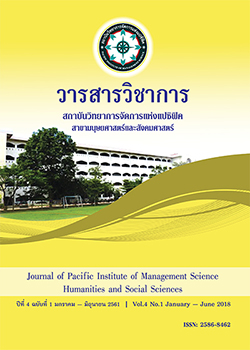The Influence of Online Channels to Convince People to do Cosmetic Surgery
Keywords:
Online Channels, Convince, Decision, Cosmetic SurgerAbstract
Research Influence of online channels on motivating consumers to make cosmetic surgery decisions. The purpose is to study online communication channels. Transfer of experience And marketing promotion influences awareness, attention, needs, and decision-making in cosmetic surgery. Data were collected from 525 Thai and American cosmetic surgeons who were members of the Association of Thai Plastic Surgeons, namely Bangkok, Chonburi, Nonthaburi, Phuket and Chiang Mai. Data were collected through in-depth interviews with 5 cosmetic surgeons using the questionnaire. And interviews respectively. Data were analyzed using percentage, mean, standard deviation. Path Analysis (Classification Analysis) (Discriminant Analysis) and Content Analysis. Online communication with Facebook gives you the most information about cosmetic surgery. Secondly, tweets, YouTube, the Internet, and the Internet. The sharing experience is a way to get information about aesthetic surgery without having to seek it. And more than advertising through salespeople, the sample has the most demand for plastic surgery. And when analyzing the overall influence of the first three causes of causal variables on cosmetic surgery decisions. This is the experience, interest and needs, with the weight values of 0.51 0.45 and 0.31, respectively. The analysis of the classification of the group who had decided to make cosmetic surgery six priority. The needs for cosmetic surgery, attention, decision-making, motivation, staff, line media, and anesthetics, and the features of a group that have never performed cosmetic surgery are three priorities: advertising, writing blogs or reviews. And the reduction, redemption, or installment payment, with the centenary value of the group had never and did cosmetic surgery were 0.551 and -0.637, respectively.
References
กิติมา สุรสนธิ. (2533). ความรู้ทางการสื่อสาร.กรุงเทพฯ: คณะวารสารศาสตร์และสื่อสารมวลชน. มหาวิทยาลัยธรรมศาสตร์.
ขวัญพร พันธุ์อุโมงค์. (2555). ปัจจัยทางการสื่อสารที่มีผลต่อการตัดสินใจของนักศึกษาหญิง ในการทำศัลยกรรมเสริมความงาม. วิทยานิพนธ์ศิลปศาสตรมหาบัณฑิต, มหาวิทยาลัยเชียงใหม่.
ชลธิศ สินรัชตานันท์. (2557, มกราคม 7). ศัลยแพทย์ชี้ศัลยกรรมไม่ใช่แฟชั่น. คมชัดลึก.
เชาวเลิศ มากสมบูรณ์. (2539). กระบวนการทำศัลยกรรมเสริมความงาม.วิทยานิพนธ์สังคมวิทยาและมานุษยวิทยามหาบัณฑิต คณะสังคมวิทยาและมานุษยวิทยา, มหาวิทยาลัยธรรมศาสตร์.
ญาณัญฎา ศิรภัทร์ธาดา. (2549). ปัจจัยที่มีอิทธิพลต่อการซื้อสินค้าผ่านสื่อพาณิชย์อิเล็กทรอนิกส์ของผู้บริโภคในเขตกรุงเทพมหานคร.สารนิพนธ์ คณะวิทยาลัยการจัดการ. กรุงเทพฯ: มหาวิทยาลัยราชภัฏสวนสุนันทา.
ณัฐปรียา ทัพมาลี. (2551). ปัจจัยที่มีผลต่อการตัดสินใจซื้อผลิตภัณฑ์ผ่านระบบเครือข่ายอินเทอร์เน็ต.วิทยานิพนธ์ปริญญาบริหารธุรกิจมหาบัณฑิต. นนทบุรี. มหาวิทยาลัยสุโขทัยธรรมาธิราช.
ดารา ทีปะปาล. (2546). พฤติกรรมผู้บริโภค. กรุงเทพฯ: รุ่งเรืองสาส์นการพิมพ์.
นิตนา ฐานิตธนกร. (2554). อิทธิพลของการบอกต่อบนโลกอินเตอร์เน็ต. Executive Journal, 1,17-22.
ปิยะ วราบุญทวีสุข. (2553). สังคมออนไลน์กับการทำธุรกิจ: แนวทางการทำการตลาด Social Network and Business: Approach to Marketing. ใน Executive Journal. หน้า 181-185. กรุงเทพฯ: มหาวิทยาลัยกรุงเทพ.
วิชชุกร ปาลเดชพงศ์. (2553). การรับรู้ข้อมูลผ่านสื่อโทรทัศน์ที่มีผลต่อการยอมรับการทำศัลยกรรมใบหน้าของผู้หญิงในเขตกรุงเทพมหานคร. วิทยานิพนธ์บริหารธุรกิจมหาบัณฑิต, มหาวิทยาลัยกรุงเทพ.
ศิริวรรณ เสารีรัตน์. (2538). พฤติกรรมผู้บริโภค (ฉบับสมบูรณ์). กรุงเทพฯ: พัฒนาศึกษา.
สมาคมศัลยแพทย์ตกแต่งแห่งประเทศไทย. (2558).รายชื่อศัลยแพทย์ตกแต่งแสดงตามจังหวัด. สืบค้นเมื่อสิงหาคม 20, 2558, จาก http://www.plasticsurgery.or.th/lst_province.php
สำนักวิจัยและพัฒนา ธนาคารกสิกรไทย. โอกาสทางธุรกิจของธุรกิจเสริมความงาม.สืบค้นเมื่อ มิถุนายน 18, 2559, จาก http://www.kasikornbank.com/TH/SME/KSME Knowledge/ KSMEAnalysis/Documents/Beauty/Oppotunity.pdf
สุเทพ สุนทรเภสัช. (2540). ทฤษฎีสังคมวิทยาร่วมสมัย พื้นฐานแนวความคิดทฤษฎี ทางสังคมวิทยา และวัฒธรรม. เชียงใหม่: โกลบอลวิชั่น.
Agarwal, P. (2004). Perception of plastic surgery in the society. Indian Journal Plastic Surgery.
Assael, H. (1998). Consumer behavior and marketing action (6th ed.). Cinninnati, OH: South WesternCollege Publishing.
Beal, A., & Strauss, J. (2008). Radically transparent: Monitoring and managing reputations online. Indianapolis: Wiley.
Berlo, D. K. (1960). The Process of Communication. Holt, New York: Rinehart & Winston.
Blackwell, R. D., Miniard, P. W., & Engel, J. F. (2001). Consumer Behaviour.(9th ed.). Manson,OH: South-Western.
Blythe, J. (2008). Consumer Behaviour. Newbury Park, CA: Sage.
Chan, G., Cheung, C., Kwong, T., Limayem, M., & Zhu, L. (2003). Online consumer behavior: A review and agenda for future research. BLED 2003 Proceedings, 43.
Denecke, K, & Nejdl, W. (2009). How valuable is medical social media data Content Analysis of the medical web. Information Sciences, 179, 1870-1880.
Farshidfar, Z., Dastjerdi, R., & Shahabizadeh, F. (2013). Acceptance of cosmetic surgery: Body image,Self Esteem and Conformity. Journal Social and Behavioral Sciences, 84(2), 238-242.
Glick, P. L., & Yamout, S. Z. (2012). Social media for surgeons: Understand it, embrace it, and leverage it for our profession and our patient. Surgery, 152(5), 941-942
Grajales, F. J. Sheps, S., Ho, K, Novak-Lauscher, H.,& Eysenbach, G. (2014). Social Media: A Review and Tutorial of Applications in Medicine and Health Care.Journal Medical InternetResearch, 16(2).
Haas, C. F., Champion, A, & Secor, D. (2008). Motivating factors for seeking cosmetic surgery: a synthesis of the literature. Plastic Surgery Nurse, 28(4), 177-82.
Heinrichs, J. H., Lim, J. S., & Lim, K. S. (2011). Influence of social networking site and user accessmethod on social media evaluation. Journal of Consumer Behaviour, 10, 347-355.
Klapper, J. T. (1960). The Effects of mass communication: An analysis of research on the effectiveness and limitations of mass media in influencing the opinions, values, and behavior of their audiences. New York: The Free Press.
Krikelas, J. (1983). Information seeking behaviour: Patterns and concepts. Drexel Library Quarterly, 19(2), 5.
Marsha, L. R., & Teri, R. S. (1988). The Role of Evolvement and Opinion Leadership in ConsumerWord-Of-Mouth: an Implicit Model Made Explicit. In NA-Advances in Consumer Research Volume 15, eds. Micheal J. Houston, Provo, UT: Association for Consumer Research, 32-36.
Opelka, F. G. (2011). Social networking in health care: Surgeons and their patients. Surgery,150(1), 2-10.
OTX. (2008). Impact of social media on purchasing behavior.Retrieved April 10, 2015, from http://174.133.170.120/files/DEIStudyEngaging%20Consumers Online-Summary.pdf
Rosen, E. (2000). The Anatomy of Buzz. New York: Doubleday.
Wong. W. W., & Gupta, S. C. (2011). Plastic surgery marketing in a generation of tweeting. Aesthetic Surgery Journal, 31(8), 6-972.
Wheeler, C. K., Said, H., Prucz, R., Rodrich, R. J., & Mathes, D. W. (2011). Social media in plastic surgery practices: emerging trends in North America. Aesthetic Surgery Journal, 31(4), 41-435.
Yamout, S. Z., Glick, Z. A., Lind, D. S., Monson, R. A. Z., & Glick, P. L. (2011). Using Social Media to enhance surgeon and patient education and communication. Bulletin of the AmericanCollege of Surgeorfs, 96(7). 7-15.
Downloads
Published
Issue
Section
License
บทความที่ได้รับการตีพิมพ์เป็นลิขสิทธิ์ของ สถาบันวิทยาการจัดการแห่งแปซิฟิค
ข้อความที่ปรากฏในบทความแต่ละเรื่องในวารสารวิชาการเล่มนี้เป็นความคิดเห็นส่วนตัวของผู้เขียนแต่ละท่านไม่เกี่ยวข้องกับสถาบันวิทยาการจัดการแห่งแปซิฟิค และคณาจารย์ท่านอื่นๆในสถาบันฯ แต่อย่างใด ความรับผิดชอบองค์ประกอบทั้งหมดของบทความแต่ละเรื่องเป็นของผู้เขียนแต่ละท่าน หากมีความผิดพลาดใดๆ ผู้เขียนแต่ละท่านจะรับผิดชอบบทความของตนเองแต่ผู้เดียว







